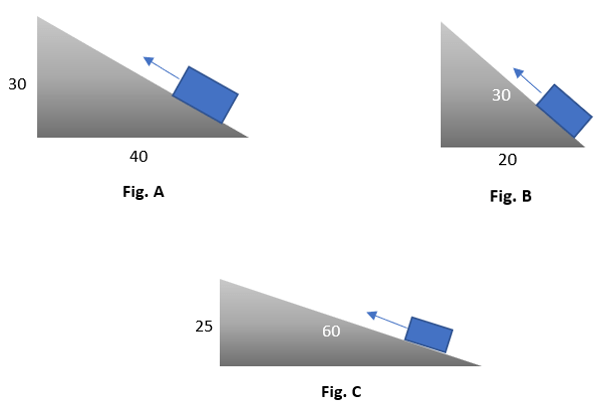This set of Theory of Machines Multiple Choice Questions & Answers (MCQs) focuses on “Mechanical Advantage”.
1. The mechanical advantage of a linkage is the ratio of ___________
a) Input torque necessary at the driven link to the exerted output torque at the driver
b) Output torque exerted at the driven link to the necessary input torque required at the driver
c) Output torque exerted at the driver to the necessary input torque required at the driven link
d) Input torque exerted at the driven link to the necessary output torque at the driver
View Answer
Explanation: Mechanical advantage is the ratio of output torque to the input torque. The link at which the torque is applied will be the driver and that which will give output is driven link.
2. The mechanical advantage of a four-bar mechanism is directly proportional to the sine of the angle between which two links?
a) Driver and coupler
b) Fixed link and driver
c) Coupler and follower
d) Follower and Fixed link
View Answer
Explanation: In a four-bar mechanism, the coupler is the link which couples the motion of the output and input link. In the below relation, ϒ is the angle between coupler and follower.
\(\frac{T4}{T2}=-\frac{ω2}{ω4}=-\frac{Rcd sinϒ}{Rba sinβ}\)
3. As the angle between coupler and driver increases, the mechanical advantage of a four-bar mechanism also increases.
a) False
b) True
View Answer
Explanation: The mechanical advantage of a four-bar mechanism is inversely proportional to the sine of the angle between coupler and driver. Hence, as the angle between coupler and driver increases, its mechanical advantage decreases.
4. In a four-bar mechanism, small input torque is required to overcome a large output torque load when mechanical advantage is __________
a) infinite
b) 0
c) 1
d) 0.5
View Answer
Explanation: When the angle between the coupler and the driver becomes zero, the mechanical advantage is infinite. At such a position only a small input torque is required to overcome a large output torque load.
5. What is the mechanical advantage of the ideal one pulley system?
a) 1
b) 0
c) infinite
d) 2
View Answer
Explanation: In a simple ideal one pulley system, the amount of effort required will be equal to the load to be lifted. Generally, in frictionless pulley systems, the number of rope sections that support the load, other than the one to which effort is applied gives the mechanical advantage of that system.
6. Mechanical advantage is a unitless quantity.
a) True
b) False
View Answer
Explanation: Mechanical advantage is the ratio of load to the effort. Let the load and effort be torques or forces, the units will be canceled out. Thus, the mechanical advantage is a unitless quantity.
7. The four-bar linkage should not be used where the transmission angle (angle between coupler and follower) is less than ________
a) 90°
b) 180°
c) 100°
d) 45°
View Answer
Explanation: As the transmission angle becomes small, mechanical advantage decreases and even a small amount of friction will cause the mechanism to lock or jam. Hence, it is preferable to keep the transmission angle as minimum as possible, generally (45° – 50°).
8. Consider a jackscrew having a handle of length L=50 cm. It is used to raise a car by 3cm/revolution of the handle. Calculate the mechanical advantage.
a) 150
b) 90
c) 105
d) 57
View Answer
Explanation: Effort × 2π × 50 = Load × 3
Mechanical Advantage = \(\frac{Load}{Effort} = \frac{2π×50}{3}\) = 104.7
9. The mechanical advantage of the inclined plane is given by________
a) The ratio of the length of the incline to the height of the incline
b) The ratio of the base of the incline to the height of the incline
c) The ratio of the height of the incline to the length of the incline
d) The ratio of the length of the incline to the base of the incline
View Answer
Explanation: Inclined wedge, ramp, etc. are used to elevate a object to certain height. Mechanical advantage of a inclined plane is the slope of the inclined plane, i.e. Tan θ, where θ is the angle between base length and inclined plane.
10. The inclined plane having a minimum mechanical advantage is _____

a) Fig. B
b) Fig. C
c) Fig. A
d) Fig. A and B has same
View Answer
Explanation: Fig. A: M.A. = 50/30 = 1.67
Fig. B: M.A. = 30/22.36 = 1.34
Fig. C: M. A. = 60/25 = 2.4
Sanfoundry Global Education & Learning Series – Theory of Machines.
To practice all areas of Theory of Machines, here is complete set of 1000+ Multiple Choice Questions and Answers.
If you find a mistake in question / option / answer, kindly take a screenshot and email to [email protected]
- Check Mechanical Engineering Books
- Practice Agricultural Engineering MCQs
- Apply for Agricultural Engineering Internship
- Apply for Mechanical Engineering Internship
- Check Agricultural Engineering Books
